which from its figure has materially favored their construction. There is every reason to believe that this eastern face must have been of great importance. A slightly raised and paved causeway of about twenty-five feet descends across the valley, in the direction of the rising sun; and being continued on the opposite side of a stream which flows through it, can be traced up the mountains at two miles distance, until it terminates at the base of an immense stone edifice, which probably may also have been a pyramid. Although a stream (Rio del Partido) runs meandering through the plain from the northward, about midway between the two elevated buildings; I can scarcely imagine that the causeway should have been formed for the purpose of bringing water to the city, which is far more easy of access in many other directions much nearer to the river, but must have been constructed for important purposes between the two places in question; and it is not improbable, that it once formed the street between the frail huts of the poorer inhabitants. The base of the large pyramid measured fifty feet, and I ascertained, by ascending with a line, that its height was precisely the same. Its flat top was covered with earth and a little vegetation; and our guide asserted, although he knew not whence he received the information, that it was once surmounted by a statue. Off the southeast corner of this building and at about fifteen yards distant, is to be seen the edge of a circle of stones about eight feet in diameter, inclosing, as far as we could judge on scraping away the soil, a bowl-shaped pit, in which the action of fire was plainly observable; and the earth, from which we picked some pieces of pottery, was evidently darkened by an admixture of soot or ashes. At the distance of one hundred yards southwest of the large pyramid, is a small one, twelve feet square, and much injured. This is situated on somewhat higher ground, in the steep part of the ascent to the mountain's brow. On its eastern face, which is toward the declivity, the height is eighteen feet; and apparently there have been steps by which to descend to a quadrangular space, having a broad terrace round it, and extending east one hundred feet by a width of fifty. In the centre of this inclosure is another bowl-shaped pit, somewhat wider than the first. Hence we began our ascent to the upper works, over a well-buttressed yet ruined wall, built to a certain extent, so as to derive advantage from the natural abruptness of the rock. Its height on the steepest side is twenty-one feet, and the width on the summit, which is level, with an extensive platform, is the same. This is a double wall, one of ten feet having been first constructed and then covered with a very smooth kind of cement, after which the second has been built against it. The platform (which faces to the south, and may to a certain extent be considered as a ledge from the cliff,) is eighty-nine feet by seventy-two; and on its northern centre stand the ruins of a square building, having within it an open space of ten feet by eight, and of the same depth. In the middle of the quadrangle is to be seen a mound of stones eight feet high. A little farther on, we entered by a broad opening between two perfect and massive walls, to a
